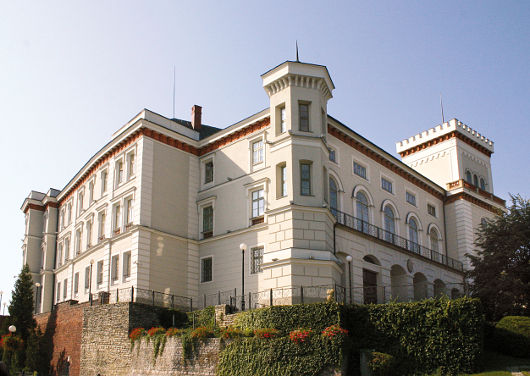Sulkowski Dukes’ Castle – history
Rising high in the centre of Bielsko-Biała, the castle is the oldest and largest building in the historic town of Bielsko. According to legend, this site formerly sheltered a settlement of robbers who would set upon travelling traders. It is said that Casimir, Duke of Opole (d. 1229/30), captured this stronghold, wiped out the bandits, and in its place constructed a hunting lodge. Over the course of time this was added to and developed into a splendid castle, around which the town of Bielsko grew.
The oldest parts of the castle date back to the 14th century. Over the ensuing centuries it was extended and transformed. Originally a town castle, it was incorporated from the outset into Bielsko’s fortifications, thereby creating the strongest element of its battlements. Over the centuries it served as a Silesian border stronghold, guarding the border between the Duchies of Cieszyn and Oświęcim, then from the mid-15th century the Czech (Bohemian)-Polish border, and after 1526 the Austro-Polish border. The castle’s defensive role diminished after the end of the 16th century, the building gradually turning into a residence for members of the nobility. Its current appearance is a consequence of the enormous reconstruction work undertaken during the second half of the 19th century. Between 1899 and 1973 there used to be an arcade of shops on the east face where now there is a brick retaining wall. This formed an impressive architectural feature of the castle. Unfortunately, the arcade was demolished when Zamkowa St. was widened.
The castle, constructed by the Duchy of Cieszyn’s ruling Piast dynasty, served as one of its seats for over two hundred years. From 1572 it was the administrative and commercial centre of the then independent state of Bielsko, governed by representatives of noble families Promnitz, Schaffgotsch, Sunnegh, Solms and Haugwitz. In 1752 the state was elevated to the rank of Duchy and became the property of the Sułkowski family. The Duchy of Bielsko existed until 1849, when modern administrative regions were introduced in Austria and the old feudal structures were dissolved. Its lands were then incorporated into new Bielsko administrative areas. The castle itself, and much of the land and property in and around the town, remained in the hands of the Sułkowski family until 1945.
After the Second World War the castle was taken over by the Polish State and served as a seat for numerous cultural institutions, including the Museum. Since 1983 the Museum, a Cultural Institution of the Silesian Voivodeship local authorities, has been its sole occupant. After 2001 it was called the Museum in Bielsko-Biała and since the end of 2013 it has been the Historical Museum in Bielsko-Biała.







